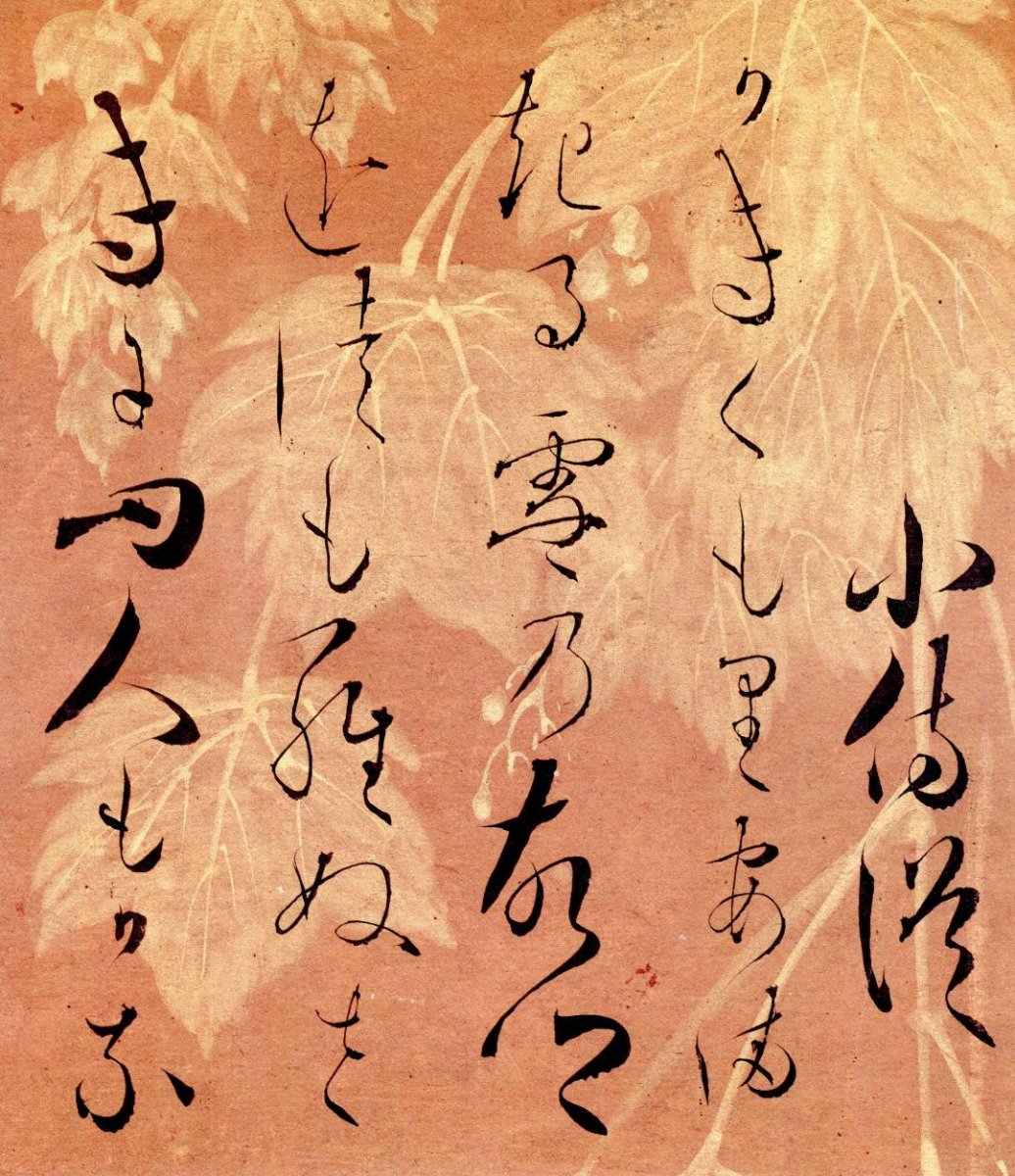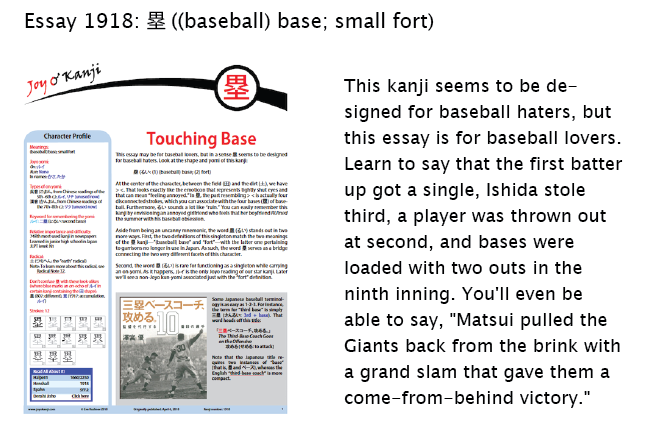Deciphering the Indecipherable
Let's start with a quiz. You may know 命 (いのち) as "life," but what do you think it could mean in the last part of this passage about the thickness and thinness of calligraphy strokes:
太いのは、そこで墨継ぎをしたからです。
The thick ones are thick because they're written right after the brush was dipped in ink.
太い (ふとい: thick); 墨継ぎ* (すみつぎ: adding ink, which involves dipping a brush in ink and continuing to write)
筆文字の美しさは墨継ぎにある、と言って良い位、墨色と墨量の加減によるその濃淡と筆圧の違いによる緩急が大切です。
The various tints coming from the (different) colors and the amount of ink and the change of pace (in writing) from the different pressure applied to the brush matter so much (in calligraphy) that it’s not going too far to say that the beauty of calligraphy lies in how one adds ink to the brush.
筆文字 (ふでもじ: brush-drawn characters); 美しさ (うつくしさ: beauty); と言って良い位 (といってよいくらい: it's not going too far to say that); 墨色 (すみいろ: ink black); 墨量 (ぼくりょう: the amount of ink); 加減 (かげん: amount); による* (by means of); 濃淡 (のうたん: light and shade); 筆圧 (ひつあつ: strength of a brushstroke); 違い (ちがい: difference); 緩急 (かんきゅう: pace); 大切 (たいせつ: important)
ボールペンやサインペンでは出せない表現の為、そこが命です。
It's a representation that cannot be achieved by ballpoint pen or felt-tip pen, so adding ink to the brush is the most important thing.
サインペン (felt-tip pen, from "sign pen," which is to say "a pen used for autographs"); 出す (だす: to produce, shown here in its negative potential form); 表現 (ひょうげん: presentation); 為* (ため: because)
It was easy to forget about 命 with so much going on, right?! Anyway, what do you think it could mean here? These are your choices:
a. way to live life
b. most important thing; foundation; core
c. most important part of life
d. matter of life and death
I'll block the answer with a preview of the newest essay:
The answer is b. That is, 命 (いのち) can mean "most important thing; foundation; core."
The comments above come from Masumi, the amazing calligrapher I consulted after an American friend sent me some Japanese calligraphy and asked what it meant:

The American friend told me that this poem comes from the early 17th century. And she asked about the varying thickness of the strokes. I passed the question along to Masumi, whose reply is above.
I need to tell you a few things about this calligraphy:
• It includes a shape that is not electronically reproducible, and I've used the similar-looking contemporary き as a stand-in.
• The calligraphy is full of hentaigana (変体仮名, へんたいがな), which are obsolete or nonstandard hiragana. Like all kana, they carry sounds, not meanings. Hentaigana derive from the cursive forms of certain kanji, so in the typed-out version of the poem you'll see things like 可 and 里, even though those exact shapes aren't in the calligraphy. The shapes that do appear aren't electronically reproducible, so our only choices for typing are kanji or hiragana.
• There are two instances in which it's too difficult to recognize shapes, so I put question marks.
• There's one case in which ぎ is written as き because archaic Japanese writing didn’t use the dakuten, the mark for voicing.
• In what I've presented below, the Japanese line and the corresponding English line aren't necessarily in the same locations.
With all that said, here's a translation found online:
now clouding over
the misty skies thick snow falls
on the ancient village
if only one guest
might come before it piles high
And here's the poem in both languages with more detail:
小侍従
Kojiju
小侍従 (こじじゅう: “minor chamberlain,” the poet's name)
可きくも里
かきくもり
now clouding over
かきくもる (掻き曇る: to be clouded over suddenly)
安満起る雪乃
あまぎるゆきの
the misty skies thick snow falls
あまぎる (天霧る: the sky becomes misty); 雪 (ゆき: snow); 乃 (の: possessive particle)
故?を
ふるさとを
on the ancient village
ふるさと (故郷: ancient village; hometown)
徒も羅ぬ左き尓
つもらぬさきに
if only one guest
つもる (積もる: to pile up); さきに (先に: before)
?人も可奈
とふひともがな
might come before it piles high
とふ (訪ふ: to visit); もがな (sentence-ending particle indicating a strong wish)
I skipped a detailed analysis because I find myself much more drawn to Masumi's explanations and a few words (like 命) that jumped out at me. This was a cool one:
解読 (かいどく: deciphering; decoding) to clarify + reading
I'm not sure why I'm so taken with this word except that I love the ideas of ciphers and codes, and therefore of deciphering and decoding. On top of that, 解 (632) is a terrific kanji. I love that Halpern primarily defines it as "to take apart." Who doesn't love taking things apart?! And I love that 解 combines a sword (刀), a cow (牛), and a horn (角), as if those are the three ingredients required to take things apart, unravel mysteries, and arrive at an understanding (理解, りかい) of the world.
Masumi used 解読 in this sentence:
どうしても解読が出来ません。
I can't decipher it after all.
どうしても (after all); 出来る (できる: to be able to)
As she made various comments, she used this new-to-me term:
日本独自 (にほんどくじ: Japan-specific) Japan (1st 2 kanji) + original (last 2 kanji)
Ah, that's so good to know! I've written for years about things like 国字 (こくじ: kanji invented in Japan), and I had no idea that a word such as 日本独自 (or for that matter 独自) existed. One can use it for anything, not just scripts.
Masumi used 日本独自 in this sentence about hentaigana (and I've split her long sentence into two parts):
たとえば、和菓子屋さんや呉服屋さんなど日本独自のお店の看板などには現在使用されている平仮名だけでは面白くないので、
For example, for shops selling Japanese-specific goods (like Japanese sweets shops and kimono stores), it's not interesting to have signs that feature only currently used hiragana, so
たとえば (for example); 和菓子屋 (わがしさん: Japanese-style confectionery); 呉服屋 (ごふくや: dry-goods store); 店 (みせ: shop); 看板 (かんばん: sign); 現在 (げんざい: current); 使用 (しよう: use); 平仮名 (ひらがな: hiragana); 面白い (おもしろい: interesting)
文字のおしゃれの為にこの変体仮名を使ったりします。
in some cases they use such hentaigana to make characters more stylish.
文字 (もじ: characters); おしゃれ (stylish); 変体仮名 (へんたいがな: hentaigana); 使う (つかう: to use)
I was thrilled from the very beginning of her sentence because I've written about both 菓子 (confections) and 呉服屋 (stores that almost exclusively sell kimono fabric now) in essays on 菓 and 呉 respectively.
There's so very much to learn about Japanese, so it's exciting when even a tiny bit accumulates—or piles up (積もる, つもる: to pile up) like snow!
Catch you back here in two weeks!
❖❖❖
Did you like this post? Express your love by supporting Joy o' Kanji on Patreon:



Comments